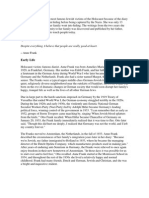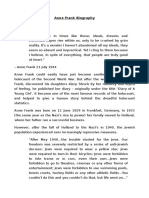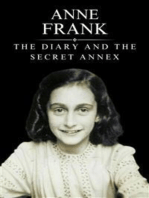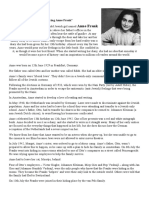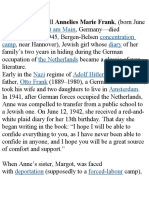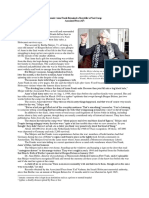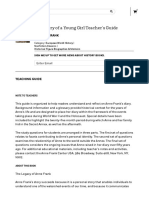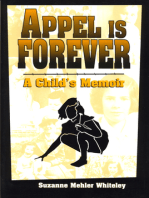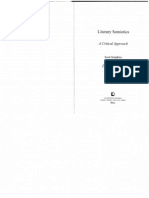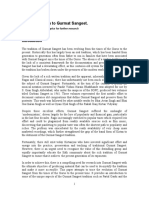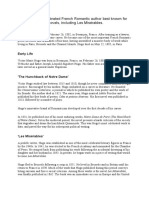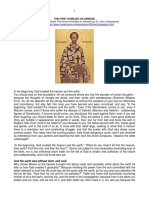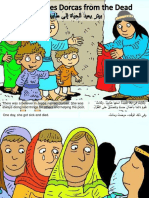Professional Documents
Culture Documents
Anne Frank
Anne Frank
Uploaded by
Ayushi SharmaOriginal Description:
Copyright
Available Formats
Share this document
Did you find this document useful?
Is this content inappropriate?
Report this DocumentCopyright:
Available Formats
Anne Frank
Anne Frank
Uploaded by
Ayushi SharmaCopyright:
Available Formats
ANNE FRANK: The Diary of a Young Girl
7Share
POSTED BY SANDHYA THURSDAY, JANUARY 27, 2011
Pic courtesy Penguinbooksindia
ANNE FRANK The Diary of a Young Girl Edited by Otto H. Frank and Mirjam Pressler Translated by Susan Massotty Published by Penguin Books India. Ages 12+ Anne Frank was an ordinary thirteen year old, who kept this diary from her thirteenth birthday for the next two years. She penned all everyday happenings, her feelings about everything and everyone around her. We have her account of her growing-up pains and joys, a lowdown on her relationships, all the yoyo-ing typical of adolescence, her darkest, deepest secrets and her hopes for the future. So how is this any different from something that anyone else might have written? Just this, that Anne was a Dutch Jew in hiding from Nazi persecutionwith her family and four other people. Other than the turmoil normal for her age, there was the fugitive existence, living life on the edge, in constant fear of discovery, and the chaos of having to live in close quarters with family and strangers, with no end to their troubles in sight. Even in this situation, the diary is so full of life, and of hope, that the reader sometines forgets that this immensely talented girl died before her 16th birthday, and the world lost someone who could probably have been a prolific writer, and an original thinker who believed in the goodness of humans. The future that Anne herself had envisioned for herself.
Some lines of note from her diary11th April 1944 :"One day this terrible war will be over. The time will come when we'll be people again
and not just Jews!"
11th May 1944 : "...my greatest wish is to be a journalist, and later on, a famous writer." 15th July 1944 : "It's twice as hard for us young people to hold on to our opinions at a time when ideals
are being shattered and destroyed, when the worst side of human nature predominates, when everyone has come to doubt truth, justice and God...Yet I cling to (my ideals) because I still believe, in spite of everything, that people are truly good at heart."
After around two years in hiding, on 4th August, 1944, their hiding place- The Secret Annexe- was discovered, and they were arrested by the Gestapo and deported. The afterword gives details of the eight members' fate. They were first taken to Westerbork, a transit camp, and then on to Auschwitz. There, the group was separated, and in late October, the two Frank girls were sent to Bergen-Belsen. Anne and her sister were together till their end, dying of typhus in early March 1945, at BergenBelsen, a few weeks before the surrender of Germany and the end of WW2 in April 1945. Otto Frank, the girls' father, was the only survivor, and he was handed Anne's diary along with other papers by Miep Gies, one of the non-Jews who helped them while they were in hiding. Otto Frank decided to publish the diary in deference to the wish Anne expresses in it to be a famous writer, and to go on living after her death. He also hoped that it could be instrumental in holding up a mirror to the horrors that can be perpetrated due to prejudice about the 'other', so that these things may happen "neveragain!" An optimistic and foolish hope! A first edition of the diary was published in 1947, after Otto Frank had edited out what he thought were the more 'private' matters- Anne's thoughts on her relationships with the members of her family, and her growing sexuality, something that he was not comfortable with revealing to the world. This latest, definitive edition has the complete text of the diary, and we get a comprehensive picture of society and of Anne's life before and after going into hiding.
You might also like
- Nitzotz: The Spark of Resistance in Kovno Ghetto and Dachau-Kaufering Concentration CampFrom EverandNitzotz: The Spark of Resistance in Kovno Ghetto and Dachau-Kaufering Concentration CampNo ratings yet
- Anne Frank Was A Teenage Jewish Girl Who Kept A Diary While Her Family Was in Hiding From The Nazis During World War IIDocument6 pagesAnne Frank Was A Teenage Jewish Girl Who Kept A Diary While Her Family Was in Hiding From The Nazis During World War IILuz María RamírezNo ratings yet
- Epistle - W.H. AudenDocument74 pagesEpistle - W.H. AudenAleksandar ArsovskiNo ratings yet
- Nazi Occupation: Best Known ForDocument2 pagesNazi Occupation: Best Known ForJoyce AgnerNo ratings yet
- Quotes: Despite Everything, I Believe That People Are Really Good at HeartDocument3 pagesQuotes: Despite Everything, I Believe That People Are Really Good at HeartMayrelle DgNo ratings yet
- Biography of Anne FrankDocument1 pageBiography of Anne FrankKOMBAN GAMINGNo ratings yet
- Anne FrankDocument8 pagesAnne FrankAkhilesh SinhmarNo ratings yet
- Anne Frank: By: Hannah Mulan Li 李木兰Document8 pagesAnne Frank: By: Hannah Mulan Li 李木兰hannah liNo ratings yet
- Anne FrankDocument4 pagesAnne FrankKeisyCastroNo ratings yet
- ANA FRANK Didactic Sequence (1) SPANISH CASTELLIAN LANGUAGEDocument30 pagesANA FRANK Didactic Sequence (1) SPANISH CASTELLIAN LANGUAGEScribdTranslationsNo ratings yet
- Annelies MarieDSFDocument2 pagesAnnelies MarieDSFScott FrostNo ratings yet
- The Diary of A Young GirlDocument2 pagesThe Diary of A Young GirlFrank QueeNo ratings yet
- The Diary That Changed the World: The Remarkable Story of Otto Frank and the Diary of Anne FrankFrom EverandThe Diary That Changed the World: The Remarkable Story of Otto Frank and the Diary of Anne FrankNo ratings yet
- Ana FrankDocument2 pagesAna Frankcarbonetti.micaelaNo ratings yet
- Diary of A Young GirlDocument2 pagesDiary of A Young GirljockimdNo ratings yet
- Independent Reading Project Anne FrankDocument20 pagesIndependent Reading Project Anne FrankSuryanshu ChatterjeeNo ratings yet
- Anne Frank BiographyDocument3 pagesAnne Frank BiographyAlena JosephNo ratings yet
- A Story With A Profound EffectDocument2 pagesA Story With A Profound EffectLisaNo ratings yet
- Jerryl Kierren Raish ADocument2 pagesJerryl Kierren Raish AJerryl Kierren Raish AlceNo ratings yet
- Ngo Vu Thu Ngan - Phase 2Document5 pagesNgo Vu Thu Ngan - Phase 2Thu NgânNo ratings yet
- The Diary of Anne Frank - ANALYSISDocument7 pagesThe Diary of Anne Frank - ANALYSISSilvy GL G100% (1)
- Biography of Anne FrankDocument2 pagesBiography of Anne FrankalejandragzmngNo ratings yet
- The Diary of a Young Girl by Anne Frank (Book Analysis): Detailed Summary, Analysis and Reading GuideFrom EverandThe Diary of a Young Girl by Anne Frank (Book Analysis): Detailed Summary, Analysis and Reading GuideRating: 4 out of 5 stars4/5 (5)
- The Diary of A Young Girl: Anne FrankDocument19 pagesThe Diary of A Young Girl: Anne FrankDivy AgarwalNo ratings yet
- Presentation 1Document11 pagesPresentation 1shubhisaravgiNo ratings yet
- Teacher's Note On The Diary of A Young GirlDocument3 pagesTeacher's Note On The Diary of A Young GirlG2214No ratings yet
- Anne Frank Book ReportDocument8 pagesAnne Frank Book Reporthendrix_salcedoNo ratings yet
- Biography of Anna FrankDocument2 pagesBiography of Anna FrankHelen CuadrosNo ratings yet
- The Girl Who Was The Victim of The HolocaustDocument17 pagesThe Girl Who Was The Victim of The Holocaustnikhil_satish_3No ratings yet
- Reading Comprehension: Anne Frank: I. Read and Translate The ReadingDocument2 pagesReading Comprehension: Anne Frank: I. Read and Translate The ReadingEduardo CharañaNo ratings yet
- Annelies Marie FrankDocument2 pagesAnnelies Marie FrankAkansha NagNo ratings yet
- Confined 2 Reading Comprehension Exercises Writing Creative W 134117Document9 pagesConfined 2 Reading Comprehension Exercises Writing Creative W 134117Matt DrewNo ratings yet
- Literary CriticismDocument4 pagesLiterary CriticismReen BanaynalNo ratings yet
- The Diary of A Young Girl - Charactersketch of All CharactersDocument6 pagesThe Diary of A Young Girl - Charactersketch of All CharactersÂdítÿa Śûd50% (2)
- 1 The Diary of A Young Girl by Ann FrankDocument3 pages1 The Diary of A Young Girl by Ann FrankSree LakshmiNo ratings yet
- Anne Frank Reaction Paper - Docx Family Is ForeverDocument4 pagesAnne Frank Reaction Paper - Docx Family Is ForeverERICA LYN PAÑARESNo ratings yet
- Grace - Anne Frank The Diary of Young GirlDocument10 pagesGrace - Anne Frank The Diary of Young GirlGrace Marselina Datu TasikNo ratings yet
- The Diary of Young Girl: 1. Basic Information About The AuthorDocument3 pagesThe Diary of Young Girl: 1. Basic Information About The AuthorTomáš RýdlNo ratings yet
- Abt Anni FrankDocument1 pageAbt Anni FrankkayalbaraniNo ratings yet
- Frankfurt Am Main Concentration Camp Diary The Netherlands Nazi Adolf Hitler Otto Frank AmsterdamDocument5 pagesFrankfurt Am Main Concentration Camp Diary The Netherlands Nazi Adolf Hitler Otto Frank AmsterdamRiya PatilNo ratings yet
- Anna FrankDocument1 pageAnna FrankbeckyNo ratings yet
- Blackmore Lebovic - Memoir - ArticlesDocument8 pagesBlackmore Lebovic - Memoir - ArticlesemreNo ratings yet
- Anne Frank BiographyDocument4 pagesAnne Frank BiographyGeorgeNo ratings yet
- Anne FrankDocument21 pagesAnne Frankpenelope.sautronNo ratings yet
- El Diario de Ana FrankDocument3 pagesEl Diario de Ana FrankYarielaNo ratings yet
- Name: Anis Binti Abu Hassan Class: 402 (Benevolent) College Number: 10522Document9 pagesName: Anis Binti Abu Hassan Class: 402 (Benevolent) College Number: 10522Anis Abu HassanNo ratings yet
- Anne Frank Research Paper ThesisDocument4 pagesAnne Frank Research Paper ThesisBuyEssaysTulsa100% (2)
- Resumen Del Extra ReaderDocument6 pagesResumen Del Extra ReaderGiuly MenicucciNo ratings yet
- Anne FrankDocument3 pagesAnne FrankIcy IzzyNo ratings yet
- Anne FrankDocument6 pagesAnne FranknoorehahmadNo ratings yet
- Diary of A Young GirlDocument20 pagesDiary of A Young GirlAKoo Sii 'redziin MAriahNo ratings yet
- Anne Frank 1Document7 pagesAnne Frank 1api-302729152No ratings yet
- Anne FrankDocument1 pageAnne Frankdivyamirchandani.bt23No ratings yet
- DiaryDocument9 pagesDiaryMaria Krystina Cassandra YañezNo ratings yet
- The Diary of Anne Frank LitChartDocument42 pagesThe Diary of Anne Frank LitChartbaglovely72No ratings yet
- Diary of Anne FrankDocument14 pagesDiary of Anne Frankraj buildconjamNo ratings yet
- Aviso Primer Examen Parcial MciDocument10 pagesAviso Primer Examen Parcial MciCanel EduardoNo ratings yet
- LegTech ReviewerDocument9 pagesLegTech ReviewerMaris Cay0% (1)
- Ren'Py: A Visual Novel EngineDocument67 pagesRen'Py: A Visual Novel EngineGivenZaneHart100% (1)
- Documentary Film 128 Spring 2012Document6 pagesDocumentary Film 128 Spring 2012Rick MexicoNo ratings yet
- Lesson Plan 4Document5 pagesLesson Plan 4Deign Rochelle CastilloNo ratings yet
- What Are The Sounds of Poetry?: Rhythm RhymeDocument2 pagesWhat Are The Sounds of Poetry?: Rhythm RhymeFranlorenNo ratings yet
- Simpkins - Derrida and SemioticsDocument12 pagesSimpkins - Derrida and SemioticskwsxNo ratings yet
- Annamacharya: Tallapaka Annamacharya (Also Popularly Known As Annamayya)Document10 pagesAnnamacharya: Tallapaka Annamacharya (Also Popularly Known As Annamayya)ravindranathkilliNo ratings yet
- Why Are We ShallowDocument2 pagesWhy Are We Shallowalexandra domingoNo ratings yet
- The Element of Jane Austen's Sense and Sensibility: 1. TitleDocument20 pagesThe Element of Jane Austen's Sense and Sensibility: 1. TitleSilvia PujiastutiNo ratings yet
- HK2 FP7 3Document3 pagesHK2 FP7 3trieuNo ratings yet
- Chips CH 5 Bright GrammarDocument3 pagesChips CH 5 Bright GrammarJawad KhalidNo ratings yet
- Pali-A Brief Overview - by S.N. TandonDocument5 pagesPali-A Brief Overview - by S.N. Tandondoron_ereraNo ratings yet
- 2017 0401 Texts Vespers YyDocument8 pages2017 0401 Texts Vespers YyLumi ElenaNo ratings yet
- How To Write A Narrative EssayDocument3 pagesHow To Write A Narrative EssayVasantha Mallar100% (1)
- Quotes For Christmas CarolDocument3 pagesQuotes For Christmas Carol262430960No ratings yet
- The Tale of ChunhyangDocument4 pagesThe Tale of Chunhyangmonalisa integroNo ratings yet
- An Introduction To Gurmat Sangeet.: History, Evolution and Topics For Further ResearchDocument12 pagesAn Introduction To Gurmat Sangeet.: History, Evolution and Topics For Further ResearchDr Kuldip Singh DhillonNo ratings yet
- New Microsoft Office Word 97 - 2003 DocumentDocument6 pagesNew Microsoft Office Word 97 - 2003 DocumentSaša VukovićNo ratings yet
- Bài Tập Về Các Thì Quá Khứ Past perfect vs past simpleDocument3 pagesBài Tập Về Các Thì Quá Khứ Past perfect vs past simpleNguyễn Hải ĐăngNo ratings yet
- Fade in Fade OutDocument14 pagesFade in Fade Outbhaskarmaji100% (1)
- Student Manual: Procedure and GuidelinesDocument104 pagesStudent Manual: Procedure and GuidelinesChaiyuth ArmyforceNo ratings yet
- Customers ExamDocument20 pagesCustomers ExamAaron RodrigoNo ratings yet
- Ahmed - 2004 - The Cultural Politics of Emotion - ReviewDocument8 pagesAhmed - 2004 - The Cultural Politics of Emotion - ReviewSandra Rodríguez CastañedaNo ratings yet
- Toward A Framework For Vietnamese American StudiesDocument4 pagesToward A Framework For Vietnamese American StudiesASIAANALYSISNo ratings yet
- ST John Chrysostom The First Homilies On Genesis PDFDocument3 pagesST John Chrysostom The First Homilies On Genesis PDFIon Vlad100% (1)
- Bob Arnold Janine Pommy Vega Part 1Document17 pagesBob Arnold Janine Pommy Vega Part 1YhonaisNo ratings yet
- Easter 1916Document15 pagesEaster 1916api-236470498No ratings yet
- بيتر يعيد الحياة إلى طابيثاDocument7 pagesبيتر يعيد الحياة إلى طابيثاfreekidstoriesNo ratings yet




